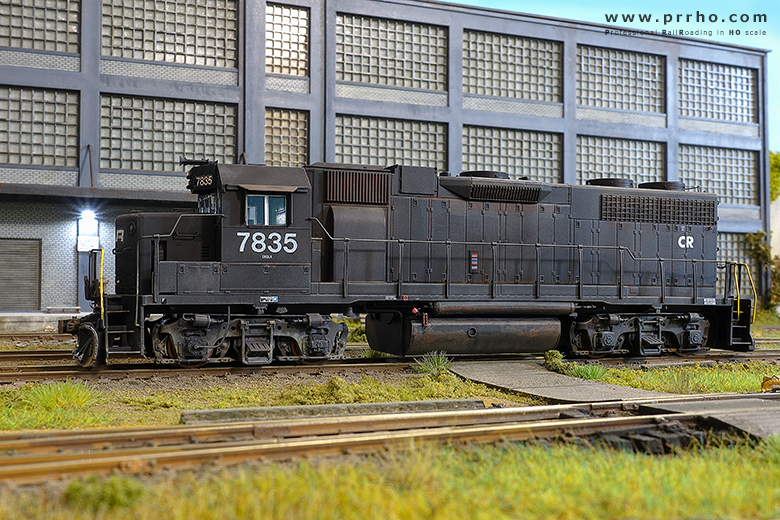Brief history.
The EMD GP38 was a non-turbocharged locomotive, similar in appearance to the earlier GP35 and GP28 models. Like the GP28, the GP38 had twin radiator fans and twin smaller exhaust pipes. The GP38, however, was 36" longer and featured a new-style radiator grille, a straighter sill, and a redesigned fuel tank. Like other locomotives, GP38s could be ordered with or without dynamic brakes, as well as a variety of other options (some had dual control stands, steam generators for passenger service, some railroads specified their own lighting options and short hood options). While initial sales of the GP38 were mediocre, after about one and half year of production many railroads discovered the advantages of this new locomotive that required less maintenance than the higher-powered major sister turbocharged GP40. The GP38's slightly lighter weight also provided greater versatility, suitable for lighter duty and for use on track that was often not for high-speed trains, and even for yard use. It was purchased for a number of regional railroads, short lines, and a small number of industrial users.
The GP38 was also popular with larger railroads, as many needed to replace older, lower-powered locomotives. The first GP38s built, in January and February 1966, were for the Detroit Toledo & Ironton (200-204). These engines featured dynamic brakes, headlights, a swinging warning light on the cab, and a bell mounted in the recess on the right side of the nose. A total of 706 GP38s were built from January 1966 until December 1971 and the Penn Central was the main buyer with 265 units. The GP38 was built with the EMD 645 16-cylinder prime mover and a D32 direct current (DC) generator, similar to all other locomotives previously produced by EMD. The push for more power, however, required larger DC generators, and in 1970 EMD introduced a new option for the GP38: an AR10 alternating current (AC) alternator in place of the generator. This was a solution to the space problems encountered by the large generator, as alternators were smaller, but offered the same electrical capacity. Thus was born the GP38AC, which is externally identical to the GP38, which has DC generators. Once again, DT&I was the first to purchase this variant of the GP38 as well. At least 240 GP38ACs were built for some american railroads.

Specifications / Technical data
Builder: Electro Motive Division
Wheels: B-B
Gauge: 4 ft 8,5 in
Loco weight: 245.000 lb
Lenght: 18 meters
Engine power: Diesel
Prime mover: EMD 645 16 cylinder
Horsepower: 2.000 Hp
Speed: 65 mph
Build date: 1966-1971
Units built: 946 (240 were GP38AC variant)

EMD GP38 #2007 c/n 33174 Missouri Pacific Lines in 1974.
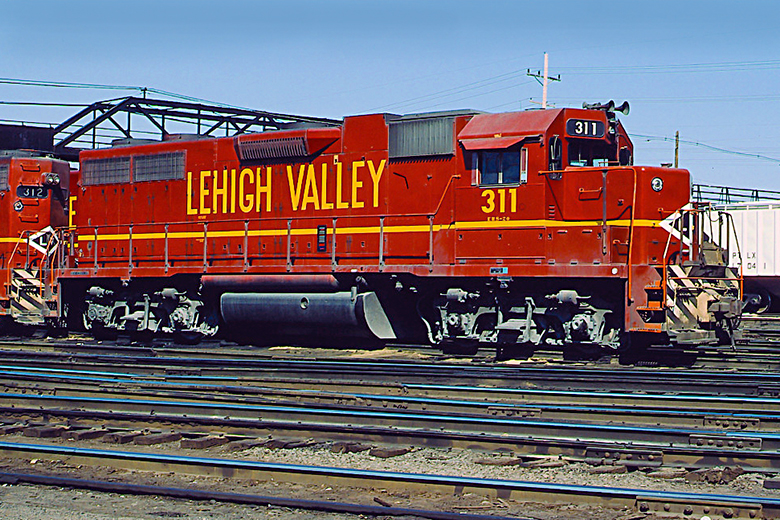
EMD GP38AC #311 c/n 7368-2 Lehigh Valley, at Sayre in 1975.
Conrail EMD GP38 #7835.
Within Conrail, the EMD GP38 was a typical workhorse for hauling heavy, fast freight trains, with a significant number of units in its roster. GP38 serial construction number 36451 was purchased brand new by Penn Central in 1970 and numbered #7835 and based at Enola Yard, Harrisburg, Pennsylvania. The unit entered in service for fast heavy freight train along PC's network among Philadelphia and Pittsburgh. With the following Conrail railroad company, as CR-7835 it worked among locomotive assets in the Pennsylvania and Ohio areas, included in the Atlantic Region, the Central Region and the Northern Region.
EMD GP38 Conrail #7835 data
Road Number: 7835
Type: B-B diesel locomotive
Builder: EMD
Built: 05/1970
CN: 36451
Disposition: Enola Yard
Previous owner: Penn Central
Remarks: ex PC-7835
Assignment: Atlantic Region
Units in CR roster: 278
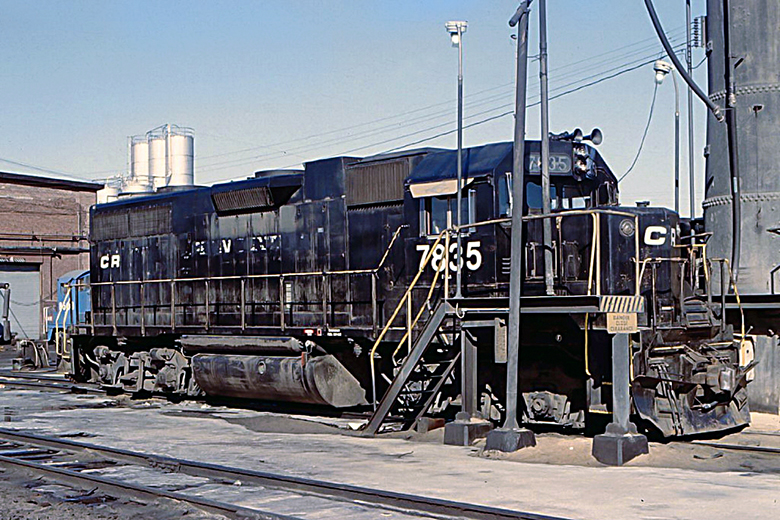
EMD GP38 #7835 c/n 36451 Conrail (ex Penn Central) in 1980.
RAPIDO TRAINS EMD GP38 Conrail #7835
Presented in mid-2022 but only released for sale from September 2024, the Rapido Trains EMD GP38 replica is a faithful reproduction of the original. PRRHO.com purchased, directly from the manufacturer, the item number SKU-038521, an EMD GP38 in Penn Central black livery and serial number #7835. The choice was made to transform this model into the Conrail GP38 with the same serial number. Later, the locomotive will be included in the Conrail Early Years 1976-1978 HO scale project.
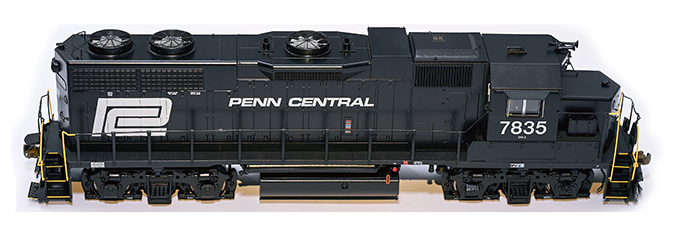
The packaging is the classic of Rapido Trains ... and that is the beautiful blue box that characterizes the products of the Canadian company. Removed from its packaging, the model shows all its quality. Upon careful visual examination, this GP38 replica has no aesthetic defects. The coloring is great and the decals are perfect and complete, even including the smallest stencils and writings.
Few operations were done for the transformation. The most important was the removal of the Penn Central logos, done with a utility knife with a very fine blade. To improve the model and make it completely the same as the real prototype, it was necessary to add a few details (the replica already has all the main details, for example the typical PRR's signal box), some already supplied as optional extras. We mounted the ACI plates, the front and rear footboards, the snow plow (an item from Detail West that reproduces the standard used by many companies in the Eastern United States). Finally, we replaced the couplers and one of the air hoses on the front (item Cal Scale number 190-621). The last job was the weathering, using some images found on the web of the real locomotive, after sticking the CR stencils.
Few operations were done for the transformation. The most important was the removal of the Penn Central logos, done with a utility knife with a very fine blade. To improve the model and make it completely the same as the real prototype, it was necessary to add a few details (the replica already has all the main details, for example the typical PRR's signal box), some already supplied as optional extras. We mounted the ACI plates, the front and rear footboards, the snow plow (an item from Detail West that reproduces the standard used by many companies in the Eastern United States). Finally, we replaced the couplers and one of the air hoses on the front (item Cal Scale number 190-621). The last job was the weathering, using some images found on the web of the real locomotive, after sticking the CR stencils.
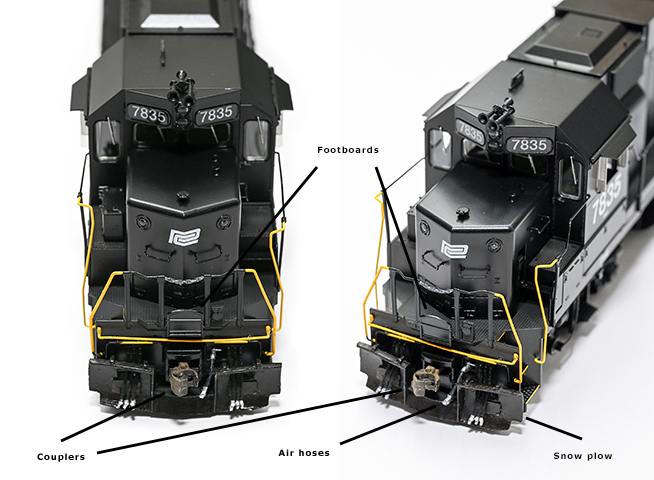
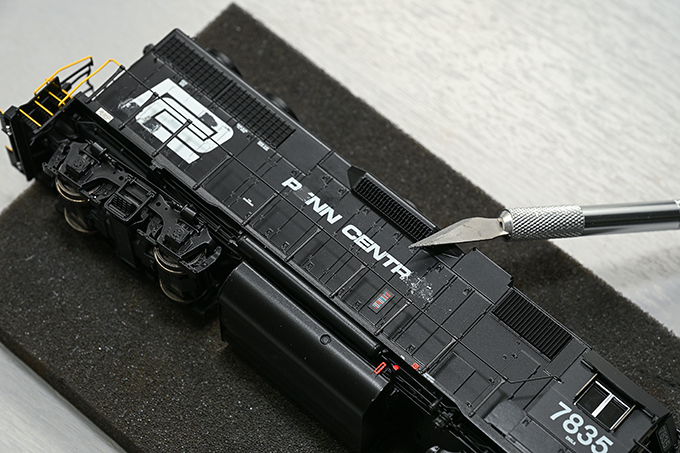
Once the aesthetic work was done, we tested the functioning of our replica. The latest version of the ESU LokSound sound decoder is excellent, with performance very similar to that of the Tsunami 2 produced by Soundtraxx. The model always runs perfectly at any speed, including the lowest ones, even on dirty tracks. A note of merit must be given to Rapido Trains about the lighting system of the locomotive, which is truly complete and well done. Are available the lights in the driver's cab, auxiliary lights on the front and rear, illuminated numberboards and walking lights.

